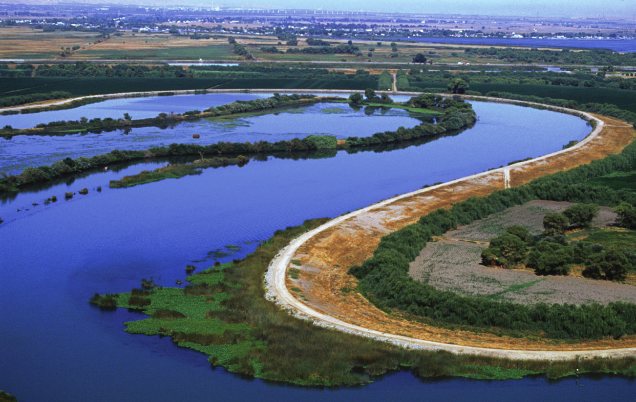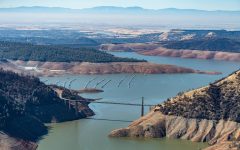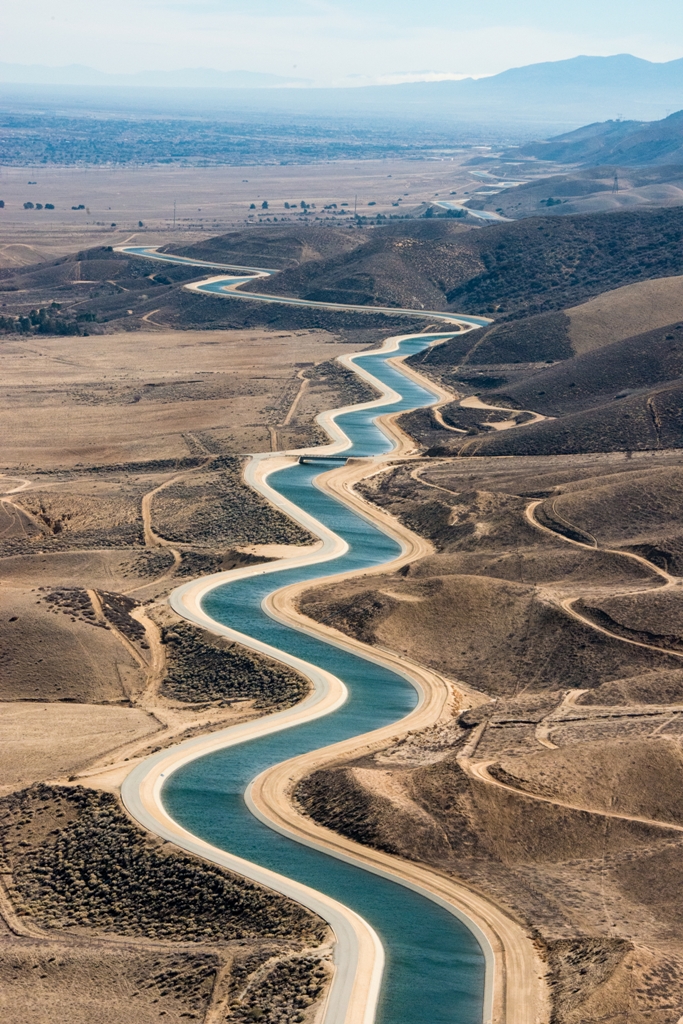
California Bay Delta water (Photo: USGS.gov)
Ringside View: California Legislature Destroys Incentive to Achieve Water Resiliency
Water rationing will not achieve the resilience that Californians are going to need in the future
By Edward Ring, November 22, 2023 2:55 am
 The California State Water Board is currently drafting the regulations needed to implement Senate Bill 1157, which is possibly the most misguided, unnecessary, intrusive, expensive disaster of a law ever passed by the state legislature.
The California State Water Board is currently drafting the regulations needed to implement Senate Bill 1157, which is possibly the most misguided, unnecessary, intrusive, expensive disaster of a law ever passed by the state legislature.
Passed and signed by Governor Newsom in 2022, SB 1147 requires California’s water agencies to limit residential indoor water use to 47 gallons per person per day starting in 2025 and 42 gallons in 2030. The theme promoted by the State Water Board as they conduct hearings and solicit public comments is “Making Water Conservation a Way of Life.” Rationing would be a more apt description of what’s coming for California’s households.
It isn’t as if conservation hasn’t been a way of life in California for decades. Despite the state’s population growing to over 39 million today, total urban water consumption in the state has been falling each year since the mid-1990s. At just over 7 million acre feet per year in 2022, urban water consumption hasn’t been this low since 1985, when the population of the state was only 26 million.
As California’s water bureaucrats move towards implementing SB 1157, the officially stated goal is to reduce total urban consumption by 400,000 acre feet per year by 2030. Put into the perspective of California’s total water withdrawals per year, this is very small potatoes. Diversions for agriculture average 30 million acre feet per year, more than four times the urban use, and diversions — captured rainfall that is released from reservoirs during the summer and fall — to maintain ecosystem health range between 20 million acre feet in dry years to over 60 million acre feet in wet years. A 400,000 acre foot reduction in urban water consumption represents barely more than one-half of one percent of the amount of water California diverts and manages even in its driest years.
For the uninitiated, SRIA stands for “Standardized Regulatory Impact Assessment,” an analysis that is required for any proposed state regulation that may have an economic impact exceeding $50 million. In March 2023, the State Water Resources Control Board submitted a SRIA to the California Department of Finance. It evaluated the impact of conservation mandates on more than 400 cities and water agencies, and concluded that over the period from 2025 through 2040, the financial impact would be a net benefit of $1.2 billion.
But despite weighing in at an impressive 186 pages, this study is flawed. For example, consumers (with subsidies from water agencies) will have to purchase high-efficiency toilets and washers at an estimated total cost of $1 billion. If only 10 million of California’s 13 million households had to purchase these upgraded appliances, that would be $100 per household, not nearly enough. Yet the “benefit” to residential suppliers is estimated at $5 billion. How? Recouping capital investments and paying overhead constitute most of a municipal water bill, and water agencies under this regulation will have to help subsidize consumer purchases, install dual meters to measure indoor vs outdoor water use, hire more staff to monitor and enforce use restrictions, and meanwhile, continue to upgrade their facilities to cope with, for example, PFAS contaminants. Then they have to spread these fixed costs and additional costs over fewer units of water sold to their ratepayers. Where is this $5 billion in “savings” to consumers going to come from?
Independent experts agree that the SRIA was flawed. Last month, MESA Water District commissioned a review of the State Water Resources Control Board’s SRIA, and tore it apart. With respect to the overestimated benefits of these regulations, MESA stated (1) “It significantly overstates supplier variable production costs and appears to double count these costs,” (2) it bases its estimates of avoided water production cost primarily on wholesale water rates even though these rates embed a sizable portion of fixed costs which in the long run are not avoidable, and (3) “it mistakes the underlying causes for escalating wholesale water rates and consequently overstates the rate at which truly avoidable costs will escalate in the future.”
With respect to the underestimated costs of these regulations, MESA writes (1) “It uses constant unit costs for conservation measures despite assuming a rapid and massive ramp-up of these programs in the first five years of the regulation,” (2) “it underestimates customer costs by ignoring the time-value-of-money costs of shifting future expenditures closer to the present,” (3) it underestimates the costs of mixed use meter to dedicated irrigation meter conversions by only counting the initial installation and inspection costs and ignoring the annual maintenance, billing, and meter replacement costs,” and (4) it grossly underestimates the costs of program creation and reporting as well as the costs to implement the new ‘Best Management Practices’ for commercial, industrial and institutional customers.”
All told, the MESA analysis estimates a net cost of $7.4 billion. For 400,000 acre feet per year of water.
The cost of water rationing isn’t merely felt financially. Imagine having to report how many people live in your home in order to qualify for your 42 gallon per person per day water allocation. Imagine having to justify your “outdoor water budget” in order to keep your outdoor landscaping healthy. It is not necessary to put ourselves through this. Cost-effective supply-side solutions are plentiful. In the water season that just ended in California, over 25 million acre feet of water passed through the Sacramento-San Joaquin Delta and out to the Pacific. This is more than twice what is required for the health of Delta ecosystems, and if that water had been stored it would have offered enough supplemental supply to withstand several years of drought.
There are many ways to store this water that fulfill reasonable environmentalist concerns. For example, channels cut into Delta islands can have gravity-fed French Drains that move water without harming fish. Feasibility studies indicate that a 200 acre site could move 15,000 acre feet per day during storms, and this water could be stored in vacant underground aquifers that are, just in the San Joaquin Valley, estimated to have a capacity of 75 million acre feet.
Other ways to realize massive increases in urban water supplies were described in detail last year in a study released by the prestigious Pacific Institute. They estimated that just through capturing urban runoff, up to 3 million acre feet could be stored each year, and that by recycling urban waste water, capturing another 2 million acre feet per year is possible. Even if these figures are optimistic, they accurately identify two additional paths to water abundance that are necessary investments anyway. Harvesting rainfall through daylighting streams and diversions into aquifers will prevent flooding and will help mitigate toxic runoff from urban surfaces. Recycling and reusing urban wastewater will eliminate the nitrogen pollution still present in treated outfall. Other options to increase water supply are additional reservoirs (Sites, Temperance Flat, Pacheco, Shasta enlargement, etc.), as well as desalination. There are plenty of ways to achieve water abundance in California.
Abundance and resilience are synonymous. Water rationing will not achieve the resilience that Californians are going to need in the future, whether it’s to adapt to prolonged droughts and bomb cyclones, or to cope with other potential disruptions to a precarious network of pipelines, pumping stations, and aqueducts. Precisely the opposite policy should be California’s legislative priority.
Water agencies need to be incentivized to increase their supply capacity, not reduce it to a fragile minimum that lacks any margin for error.
- Ringside: EVs and California’s Future Demand for Electricity - December 4, 2025
- Ringside: Politically Viable Water Supply Projects - November 27, 2025
- Ringside: Shifting Costs Does Not Solve California’s Electricity Shortages - November 20, 2025





And the legislature will label it the “Abundant Water for You” act, and the media will keep this silent and out of the news.
The water Nazi’s must be getting paid off by someone.
Ed Ring is a California treasure. Folks would do well to read his water series at the California Policy Center.
The theme of this legislation is suspiciously aligned with the World Economic Forum’s theme of “You’ll own nothing and be happy”.
Also suspiciously, Gavin Newsom has been aligned with the “Young Global Leaders” program for decades now, and his Water Board has been pushing this scarcity agenda the hardest.
Fortunately, The Good Lord has Blessed us with abundant rainfall last winter, a mild summer and another anticipated rainy “El Nino” winter this year, but from a policy and resource management perspective, if California residents were paying attention to the goings-on in Sacramento, rather than dumbing themselves down over “The Bachelor” on teevee, they’d be outside the castle gates with pitchforks and torches to burn down the State Capitol for the MIS-management of water, the fundamental element of life!
Between BAD water, energy and INSURANCE, we are looking from an exit from my home state, because the doofuses that somehow seem to keep getting (s)elected (Dominion), are setting policies that are making this state uninhabitable unless you’re a multi-millionaire…
WAKE THE HELL UP, people, and force changes that result in ABUNDANCE and TRUE conservation of water, not wasting billions of gallons of water into the ocean every time it rains.
What a STUPID state California is…
The CA legislature and water resources board should subsidize purchase and installation of rain collection barrels. This years El Nino will be wasted! They legislature should underwrite the transfer of “for profit” water companies whose reason for existence is to sell more water (or charge more for less), to not-for-profit transparent public agencies. Residents should have a choice to buy water from a not-for profit agency.
Lastly, the Water Board should focus on inventorying and replacing lead pipes, connectors and galvanized service lines. They have failed to assist local agencies in applying for and using BILLIONS of dollars in the Bipartisan Infrastructure Legislation. Lead is directly linked to neurological development and learning difficulties in children and later behavioral problems (testing of teeth of kids in juvenile detention show higher lead levels!) In adults high lead levels are linked directly to heart disease. Tell the state water board to GET THE LEAD OUT!
Mr. Ring, nicely written and thorough article.
Water rationing is all part of the Democrat agenda to turn California into a Third World state with shortages, decay, crime, uneducated, poverty, and government control of the population.
We have to turn this around. We need Republicans in office.
So glad I am not on a government water system.
Has the additional air pollution of people driving their clothes to Laundromats to save household allowance water been considered?
And those with gardens? Please do not attack agricultural. Imports from other areas are usually grown with lower standards.